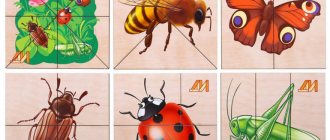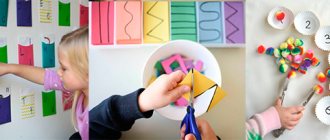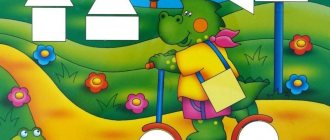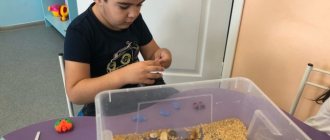For the development of a harmonious personality, mathematics classes for children will be very useful, which can be started from 3-4 years old - it is at this age that children begin to develop their first mathematical concepts. Do not forget that preschoolers should be taught through play, using dolls, pictures, unusual methods and techniques to maintain interest - this is the only way the effect will be maximum, knowledge will be stored in the head for a long time, and the child will not lose interest in the process.
Tips for parents
To make math classes not only useful, but also interesting and fun, you should adhere to the following recommendations:
- Act according to the principle “from simple to complex”: first offer the child those tasks that he can cope with, do not rush, work through the material in detail and do not take on new things while there are gaps in the old. You should not compare your child with other children, because everyone’s development follows an individual path, and what is understandable to one child may be very difficult for another. This is important to consider.
- Parental praise is a powerful motivation and should always be used, even if the successes are not impressive. You can at least praise your efforts.
- Of the two options - to hammer useful material into the child’s head at any cost or to instill in him curiosity and a desire to learn - without a doubt, you need to choose the second. Over time, the child will remember numbers, quantities, and learn to navigate in space, but if he loses interest in the process, then it will not be easy to regain it.
- Correct choice of task. The secret of success is to give the child a moment of small discovery, so tasks need to be selected so that he can cope. Success will help you gain and strengthen self-confidence.
You shouldn't push your baby. If he uses his fingers when learning to count, it’s okay. Very often, those children who have already learned to count orally test themselves in this way. Over time, they will gain self-confidence and will not use their fingers.
Learning colors
Your child can easily remember the primary colors when you visually show him a few objects.
Red color
Show your child the picture and look carefully at what is shown on it. Speak out the object that is drawn on it and always the color of this object.
Any picture will enlarge if you click on it:
The picture shows a red ball.
The picture shows a red bow.
The picture shows a red tomato.
The picture shows a red car.
The picture shows a red umbrella.
Blue color
Look carefully at each picture with your child and repeat that the color is blue.
The picture shows a blue ball.
The picture shows a blue umbrella.
The picture shows a blue car.
The picture shows a blue bird.
Yellow
Look carefully at each picture with your child and repeat that the color is yellow.
The picture shows a yellow pepper.
The picture shows a yellow star.
The picture shows yellow bananas.
The picture shows a yellow car.
The picture shows a yellow sun.
Green color
Look carefully at each picture with your child and repeat that the color is green.
The picture shows a green cucumber.
The picture shows a green horse.
The picture shows a green ball.
The picture shows a green turtle.
The picture shows a green leaf.
White color
Look carefully at each picture with your child and repeat that it is white.
The picture shows a white bunny.
The picture shows a white horse.
The picture shows a white fox.
The picture shows a white dove.
Black color
Look carefully at each picture with your child and repeat that the color is black.
The picture shows a black bird.
The picture shows a black cat.
The picture shows a black horse.
The picture shows a black car.
After learning all the colors, look and do the following exercises. Your child can strengthen his new knowledge. After learning the colors, play visually with your child. Here the child will use auditory memory, visual memory, and attention.
Tasks and exercises by age
The simplest options for preschoolers 3–4 years old are games with fingers.
- Using your fingers, show the same number in different ways (for example, 5 is 4 and 1, 2 and 3, 5 and 0).
- It is necessary to bend several fingers, the child’s task is to name the exact number.
In addition to fingers, you can use other counting materials - buttons, sticks, pencils, shells - anything that is interesting to the baby.
Exercises at home
There are many interesting games that you can play at home with kids 3-4 years old. For example, circle a number. The mother prepares the material in advance - on a piece of paper she writes numbers familiar to the child in a chaotic order, then asks him to find all the twos and circle them. The task can be made more difficult by suggesting that you circle the twos in blue, the threes in green, and the ones in red.
Mathematics is not only counting, but also logic, so you can play the game “Make a bouquet” with your child. To do this, draw a blank: simple pots, from which three stems are visible. You also need to prepare a set of buttons in three colors in advance. Next, mom gives the task - to select “flowers” for each pot so that one of them must be blue or so that there are blue and red flowers next to each other in each pot. The task is also good because it trains fine motor skills.
You can come up with games yourself using available materials. For example, invite your child to make a caterpillar out of multi-colored buttons, using 3 red, 4 blue, 1 green buttons. So that the baby does not forget the combinations, you need to draw a square, paint it with the appropriate color, and write a number next to it. Using colored rectangles, you can make a train with carriages in the same way.
Many children love to draw and color; this can also be used during classes by offering kids coloring books with numbers (you can draw them yourself or use ready-made options). The essence of such drawings is simple: the child is given a picture that he needs to color in different colors. The image is divided into blocks marked with numbers, each of which has its own color.
At 3–4 years old, children need to be introduced to geometric shapes. The following tasks are suitable for this:
- The parent draws a series of shapes (circle - square - triangle - rectangle), then asks the child to show, for example, a circle.
- Further, the task becomes more complicated - you need to color the circle red, the square green, the triangle blue, and leave the rectangle white.
To prevent your child from getting bored, you can come up with a fairy tale about the magical world of figures who are in trouble. Only completing tasks correctly will help save them.
Outdoor games
Don’t think that math classes with a preschooler are something boring. If you get creative, you can have some fun. So, there are several fun and useful games:
- "One to four." The mother hums a song and then says a number from 1 to 4. As soon as it sounds, the child must take a certain position, touching the floor with the number of points indicated by the named number (for example, if it is 1, then you need to stand on one leg, if 2 - just stay standing on two legs, 3 – lean on your hand and both legs, 4 – on your arms and legs at the same time).
- "Meow-woof." The mother gives the instruction: the child must jump forward as many times as she says “meow”, and back as many times as she says “woof”. To perform this, the baby first counts his mother’s phrases, and then his own jumps.
You can do math with your little one on the street, asking him to count all the cats he meets on the way, or find the number 3 everywhere, or show him objects that are shaped like a circle. You can also ask your child to compare which car is bigger, what is next - a shop or a store, and give similar tasks.
Obtaining mathematical skills can and should be organized in a playful way. Only in this case will the child have fun and unnoticed remember the necessary material.
MAGAZINE Preschooler.RF
Topic: “Little mathematicians visiting the Tsokotukha Fly” Prepared by teachers: Dyakonova S.A., Mikhailyukova O.N., Kalashnikova L.A. Program tasks: Improve the ability to distinguish and name geometric shapes (square, circle, triangle). To develop the ability to distinguish between the concepts “many” and “one”. Strengthen the ability to distinguish and name parts of the day: (night, morning, day, evening). Practice naming the colors of the spectrum (red, white, yellow). Cultivate goodwill towards fairy-tale characters. Create a desire to help those who need help, and receive satisfaction from this. Progress of the lesson Teacher. Guys, we are going to a fabulous birthday girl, and you have to guess who. “Fly, fly - clattering, gilded belly.” Who is this tale about? Children. "Fly Tsokotukha". Educator. That's right, this fairy tale is called “The Cluttering Fly.” The teacher shows the children a drawn fly. The night passed, the darkness took away, the sun woke up, appeared in the clearing and children came. Morning. The teacher places the drawn sun over the clearing. Educator. Our clattering fly woke up, stretched and went out into the clearing. And flowers of extraordinary beauty grew in the clearing. The teacher lays out flowers of different colors on the easel: blue, red, yellow, white. The Fly is lost in thought, looking at the flowers and not knowing what color they are? Let's tell her what color this flower is? The teacher points to the flowers, the children name their color. Educator. How many flowers are there in the meadow? Children. A lot of. Educator. How many blue flowers? Children. One. Children list flowers. Educator. Mukha admires the beautiful flowers, and they smell so wonderful. Let's all smell what the flowers smell like together. The teacher conducts breathing exercises “Let’s Smell the Flowers.” The fly enjoyed the floral aroma and moved on. The fly walked and walked, the fly found the money. The teacher shows the children a “drawn” money. Educator. What shape is the coin?Children. Round.
Educator. How did you guess that it is round?
Children. She has no corners.
Educator. Our Tskotukha Fly has a birthday today, she invited many guests. So she went to the market to buy a samovar.
The teacher places drawings of three samovars of different colors and heights on the easel.
Educator. What color is the largest samovar?
Children. Yellow.
Educator. What color is the smaller samovar?
Children. Green.
Educator. What color is the smallest samovar?
Children. Blue.
Educator. How much water for tea can be poured into a large samovar?
Children. A lot of.
Educator. How much is the smallest one?
Children. Few.
Educator. Many guests will come to the clattering fly. In order for everyone to have enough tea, what color samovar should she choose.
Children. Yellow.
Educator. Why a yellow samovar?
Children. He's the biggest.
Educator. Will there be enough tea for all guests?
Children. Yes.
Educator. The clattering fly bought a large samovar and went home.
Game “Choose a circle of the right size.”
The teacher invites children to choose circles of the desired size using overlay techniques.
Educator. At home, she covered the table with a tablecloth, placed the samovar on it and began to wait for the guests.
The teacher displays an image of a festive table with a samovar.
At this time the sun rose high in the sky and...
Children. Day.
The teacher moves the sun at the top of the easel to the center.
Educator. Mukha is waiting for guests, but there are still no guests. How many guests came to Mukha?
Children. No one.
Educator. Because of this, the birthday girl’s mood deteriorated and she became sad. Let's try to cheer her up by singing her the holiday song "Loaf". And then Grandma Bee was the first to fly in and bring honey to the clattering fly. Fleas came to Mukha and brought her boots. The Grasshopper galloped up and gave the Fly a gift in a square box. Komarik arrived and gave Mukha a gift in a round box. A worm crawled to Mukha and gave him a gift in a triangular box, and the guys want to give you gifts made with their own hands.
Game "Geometric Shapes".
Educator. While the guests were celebrating, the sun began to go down, and...
Children. Evening.
Educator. The buzzing fly thanks you guys for helping her have a fun birthday: telling her what color the flowers are in the meadow, choosing a samovar for her guests, and lifting her spirits with your song. The fly says to you: “Thank you very much!”
Evening came and all the insects hid in the flowers.
| Next > |
Exercises
Exercise one
Look carefully at the picture of the child and ask him a few questions about the picture.
Find and show the blue rectangle.
Are there red squares in the picture?
What color are the triangles?
Find and show a black circle.
What color are the squares?
What color are the rectangles drawn in?
Exercise two
Look carefully at the picture of the child and ask him a few questions about the picture.
What shapes does the house consist of?
What color are they?
What geometric figure does the sun resemble?
What color is the sun?
About counting on fingers
At the first stage of learning to count on fingers, you need to firmly grasp all possible combinations. The child should not think about the answer within one hand.
Kids dancing: how to support your child before a performance in the garden
Attentiveness and memory develop, including tactile memory, because counting takes place in the head. You have to hold several data in memory at the same time. A quick solution depends on intelligence and speed of perception.
Child counts on fingers
Before learning to count on fingers, the child is already familiar with the concepts of “more,” “less,” and “also.” Can count objects in order within five.
Further:
- You need to start with 1+1=2. Children put two fingers together and get 2.
- Then add another finger = 3.
- Add one more to three and get the fourth result (four).
- Add one more finger to four and get five.
Now you can master subtraction:
- Subtract one finger from five and it becomes four.
- Subtract one finger from four and it becomes three.
- If you take away one finger from three, there will be two left.
- Subtract one finger from two and one remains.
The lesson should not exceed 20 minutes. Children get tired quickly. You can diversify the lesson by changing activities - warming up, singing something, solving riddles, and so on.
Important! You can't force it. It is always easier to “lure” someone somewhere than to force them. Elements of play, competition and reward will do more and better than anything else.
Exercises
Exercise one
Look carefully at the picture; different objects and numbers are drawn on it.
In the first line you need to count the ducklings and connect them with the number.
In the second line you need to count the bunnies and connect them with the number.
In the third line you need to count the squares and connect them with the number.
Exercise two
In this exercise, you need to draw objects against each number.
In the first line, opposite the numbers, you need to draw red balls.
In the second line, opposite the numbers, you need to draw yellow cubes.
In the third line, opposite the numbers, you need to draw green circles.
Exercises
Exercise one
Look carefully at the following picture with your child. We need to answer questions.
Which ball is smaller?
Which ball is bigger?
What color is the little ball?
What color is the big ball?
How many balls are there in the picture?
Exercise two
In this exercise, you must correctly name the concepts high, low, small, large, one, many. Look carefully at each item.









